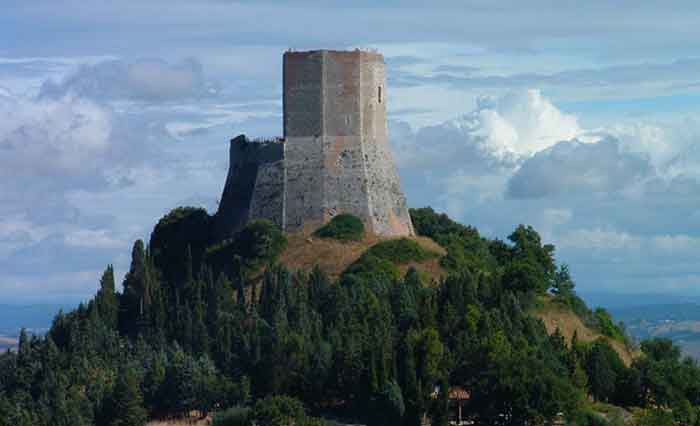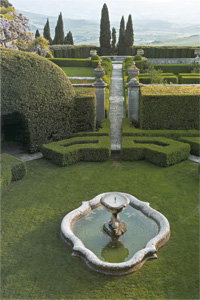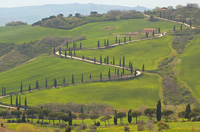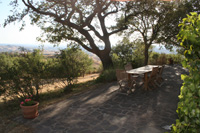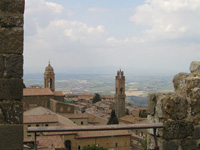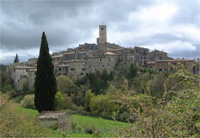|
Castiglione d'Orcia marks the boundary between Val d'Orcia and the Monte Amiata forests. Once the property of the Aldobrandeschi, family it was fought over in the 14th century between the Salimbeni family and Siena.
|
||||
| Rocca d'Orcia Worth to be visited is the Rocca of Tentennano in the tiny borough of Rocca d’Orcia, which is one of the most famous fortification in the area. The Rocca of Tentennano crown a rocky crag upon the medieval suburb. Although larger, the village of Castiglione d'Orcia is somewhat less visited than Rocca d'Orcia, its sister village. The reason is that the once dominant fortressof Castiglione d'Orcia lies in ruins, while the Rocca di Tentennano of Rocca d'Orcia has been well-preserved. Castello di Ripa d'Orcia |
||||
Castello di Ripa d'Orcia, an ancient medieval castle, is a comfortable country residence set upon a rise in the centre of Orcia Valley.
|
 |
|||
Castello di Ripa d'Orcia
|
||||
|
|
||||
 |
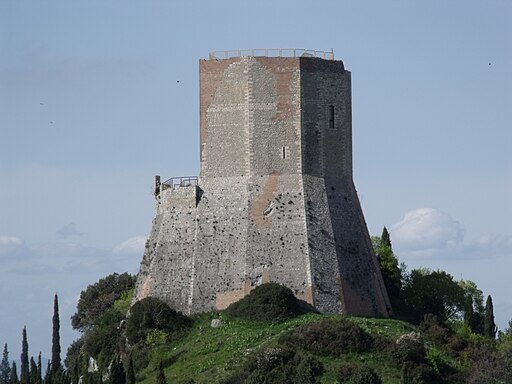 |
 |
||
Rocca d'Orcia, seen from Bagno Vignoni
|
Rocca d'Orcia | The Castle Rocca Tintinnano (also called Tentennano or Tintennano) in Rocca d’Orcia, Castiglione d’Orcia
|
||
 |
 |
 |
||
Chiesa di San Simeone
|
Chiesa di San Sebastiano, Rocca d'Orcia | Ex-Church Chiesa del Palazzo on Piazza Cisterna in Rocca d’Orcia, Castiglione d’Orcia, Val d’Orcia | ||
| Enlarge map Val d'Orcia | ||
|
||
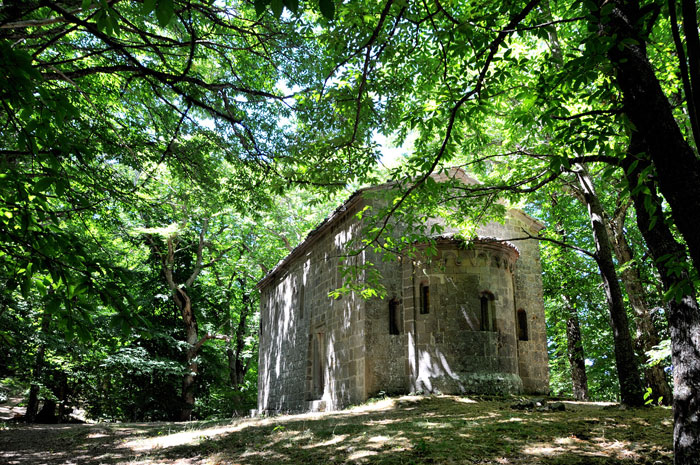 |
||
Vivo d'Orcia | Eremo in estate [Copyright © All rights reserved by Bruno Brunelli] |
||
| Vivo d'Orcia is a splendid outlying district of Castiglion d'Orcia, set in a valley outside time. At the foot of the castle, the river Vivo runs whose sources rise in the locality of Ermicciolo. Starting in the middle ages flour-mills, paper-mills and ironworks were built along the torrent and, in the 1920’s, one of the first hydroelectric power stations. Traces of these old buildings, covered with climbing plants, may still be seen here in one of the area’s most beautiful and evocative landscapes. On the occasion of the Water Festival, held in Ermicciolo every 22nd March, you can visit the source of the Vivo which gushes out of the rocks. |
||
| The walk from Ermicciolo to Eremo, along the river, is absolutely one of the finest in the Amiata area: you can stop at the little waterfalls and the dam in the middle of the woods, or the caves where partisans hid during the last war, or the archaeological sites that have brought to light finds dating to Mesolithic and Etruscan civilisations. You may even see one of the rare green woodpeckers whose sound is sometimes heard echoing among the centuries-old trees. The Vivo Valley is one of the few places on earth where you may be convinced that you’re still living in the middle ages. The name Vivo (meaning 'Alive') was adopted because of the lively, powerful industrial heart and from the wild and crashing river Vivo that ran through the village's six water-mills, once used for iron-works, olive crushing and fine paper production. The purity, power and potential of the river's water, pouring from the family's vast natural volcanic spring on Monte Amiata had long been harnessed by the Vatican who, via Pope Marcello II established a gigantic Papal Castle, using a rather illuminated architectural principal for its time, which aimed to make the Vatican's buildings more humble and more accessible to the local community Renaissance Palace (Palazzo), all designed by the famous 16th century architect of the Vatican Antonio da Sangallo for the Pope's living quarters. A Romanesque chapel and an extensive hermitage (Eremo) were also constructed to accommodate for a fascinating group of humble monks, known as the Camaldolesi, who first inhabited the caves that now form the foundations of the castle in 1,004 ad (500 years previously). Along with this impressive estate the church established one of the largest and finest industrial centres of the 16th century, way surpassing anything built up until that time. |
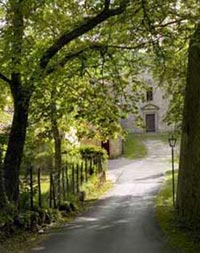 Borgo dell'Eremo and Chiesa di San Marcello |
|
| The village of Bagni San Filippo owes its existence to the hot water springs whose therapeutic properties have been known since ancient times. It is believed that the spa dates back to Etruscan times and the existence of a settlement in the era of Imperial Rome is well documented. After scientific analysis of the waters in the XVIII century the popularity of the spa grew for treating skin problems, arthritis, rheumatism and disorders of the respiratory tract. At the beginning of the XIX century a new spa resort was built able to guest more people and within the village some buildings became hotels which still exist today. Well worth a visit is the Grotta San Filippo, carved from a block of travertine, it is reputed to have been the refuge of San Filippo Benizi in 1267 when trying to avoid being elected Pope. Nearby is the Fosso Bianco (photo) where the hot water springs flow down leaving calcareous deposits which over the centuries have transformed the hillsides into white rock naturally sculpted into varying shapes. Films set in Tuscany | Le Meraviglie Le Meraviglie (Alice Rohrwachter, 2014) is a magical realist portrait of a family of beekeepers in rural Italy. The film, which stars Monica Bellucci, was shot in Sorano, Sovana and some areas of the province of Grosseto and in the town Bagni San Filippo, in the province of Siena. |
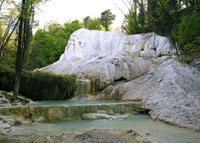 Bagno San Filippo |
|
| The hamlet of Bagno Vignoni dates back to Roman times and a Latin inscription on travertine rock, found on the left side of the spa establishment bears witness to this. The waters rise up from a depth of 1000 metres at a temperature of 52°C and flow into a stone pool which is 49mt in length by 29mt in width. Due to the high concentration of magnesium and calcium sulphate, the waters are particularly beneficial for treating disorders of the skin, bones and mucous membranes. Lorenzo il Magnifico of the Medici and Santa Caterina of Siena were regular visitors and the enchanting loggia which faces the pool was name after this saint. Films set in Tuscany | Nostalghia
|
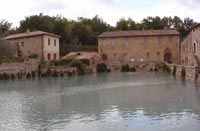 Bagno Vignoni boasts one of Italy's most unique town squares |
|
| Villa La Foce is a serene, ochre-coloured building standing high above the vast, open landscape of the Val d'Orcia, its view stopped only by the rugged profile of Monte Amiata. The garden is a magnificent melange of English and Italian influences. The garden of Villa la Foce in the Val d'Orcia was created by Cecil Pinsent for Iris Origo and her husband. Villa La Foce was first built in 1498 as a hostel for merchants and pilgrims travelling along the Via Francigena to Rome. In 1924 it was bought by Antonio and Iris Origo, philanthropists whose dream was to restore not only the house but also the estate farms to full working order at a time when investment in the region was desperately needed. Iris Origo was an aristocratic Italian writer who dreamed of creating a new society. Several of her books were international bestsellers when published and many remain in print decades later. Origo is best known for her diary, War in the Val D'Orcia. 'The desire to reconstruct a new society drove the couple. Their decision to do what they felt to be morally right, rather than what was socially acceptable among their class, came to be what La Foce and the Origos were remembered for, as one of the only aristocratic families in Italy who helped escaping prisoners, partisans and deserters during the second world war. "What a fine long journey we have travelled together!" Iris wrote to Antonio in a 1976 letter to be read in the event of her death. It was premature. She outlived her husband, but the challenges had already been considerable: a harsh terrain, superstitious Tuscan villagers and a war that made itself felt with air raids, prisoners of war, orphans and evacuees, partisans fighting German soldiers in the hills.'[1] |
||
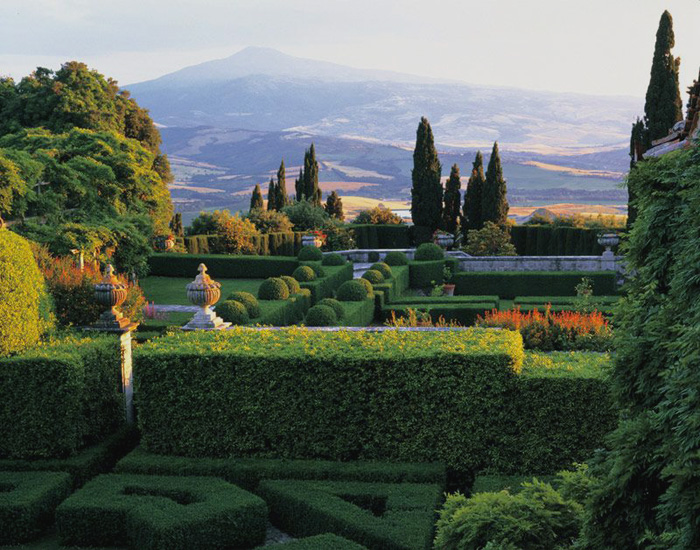 |
||
A view across the garden towards a horizon dominated by the volcanic peak of Monte Amiata |
||
| Opening hours: the garden is open to the public every Wednesday afternoon. Guided tours leave from the Fattoria courtyard every hour from 3 to 7 PM (April-September) and 3 to 5 PM (October-March). Gardens in Tuscany | Villa La Foce Villa La Foce Estate | La Foce - 61, Strada della Vittoria -53042 Chianciano Terme - Siena | www.lafoce.com |
|
|
|
|
||
| Castiglione d'Orcia borders the following municipalities: Abbadia San Salvatore, Castel del Piano, Montalcino, Pienza, Radicofani, San Quirico d'Orcia, Seggiano. Bagni San Filippo, Belvedere, Campiglia d'Orcia, Masse, Montieri, Osteria Gallina, Ripa, Rocca d'Orcia, Vivo d'Orcia are frazioni of Castiglione d'Orcia. |
||||
[1] Selma Dabbagh, Iris Origo: the author honoured by a music festival, The Guardian, Friday 6 July 2012 Historic Centre of the City of Pienza | whc.unesco.org Helena Attlee, Italy's Private Gardens: An Inside View, Frances Lincoln Limited 2010, London, pp 103-113 Walking in Tuscany | Hiking from Castelnuovo dell'Abate to Rocca d'Orcia | www.girosole.com |
||||
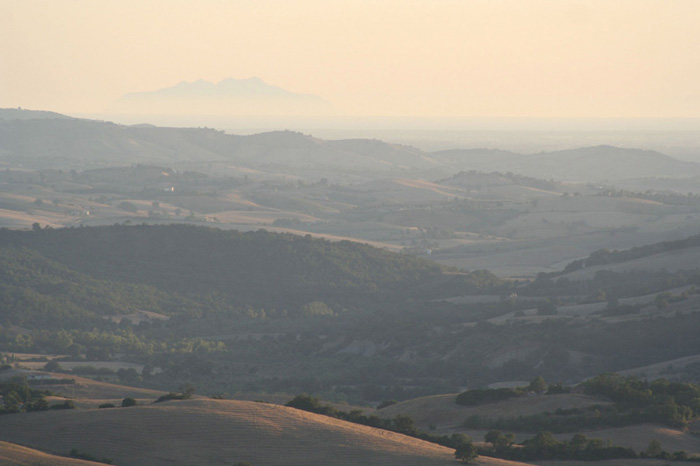 |
||||
Podere Santa Pia situated in panoramic position in the Maremma countryside
|
||||
Podere Santa Pia |
Podere Santa Pia, garden |
Podere Santa Pia, terrace |
||
Pienza |
Montalcino |
San Casciano dei Bagni |
||
Tenth Sunday after Easter, the famous flower carpet procession Corpus Domini in Castiglione d'Orcia - Pienza - Monticchiello. A procession moves through the streets of the country, formerly embellished with gorse and rose petals.
|
||||
Wines in Tuscany | Organic Wine in Tuscany |
||||
| Podere Santa Pia is located 3 km from Castigliocello Bandini, 15 km from Abazziia San 't Antimo and Montalcino, close to art cities like Siena, Pienza, Montepulciano and San Quirico d'Orcia, and 1 hour away from the seaside. Grosseto is Tuscany`s most southernly province and is considered to be the capital of Tuscan Maremma. Grosseto is the most southern Tuscan province. The town is situated about 12 kilometres from the sea, in the heart of Tuscan Maremma, a wide alluvial plain. In the past, the lake Prile spread over most of this territory. The lake has almost disappeared due to the drainage works undertaken in this area during the centuries. The various natural reserves surrounding Grosseto witness nonetheless Maremma`s past as a marshland. South of Grosseto flows the Ombrone, the most important river in southern Tuscany. At the river mouth there is the Parco dell`Uccellina. The ancient city walls built in 1574 under Grand Duke Francesco I de` Medici still surround its historical centre. Situated in a former marshland that was once infested with malaria, at present the province of Grosseto is a real paradise for those who love culture, nature and good cuisine. Grosseto countryside is scattered with ancient Etruscan towns, such as Roselle, Populonia and Vetulonia. Those who love nature can visit the Parco Naturale della Maremma (Maremma Natural Park), the Riserva Naturale Diaccia Botrona (Diaccia Botrona Nature Reserve) and the Parco Nazionale dell`Arcipelago Toscano (Tuscan Archipelago National Park) and spot some dolphins and whales in the Santuario dei Cetacei (Cetacea Sanctuary). Principina a Mare and Orbetello lagoon are renowned seaside resorts, whereas in the interior there is Saturnia with its famous spas. |
||||
|
|
||||

